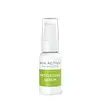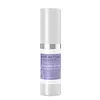What's inside
What's inside
 Key Ingredients
Key Ingredients

 Benefits
Benefits

 Concerns
Concerns

No concerns
 Ingredients Side-by-side
Ingredients Side-by-side

Water
Skin ConditioningLactobacillus/Kelp Ferment Filtrate
Skin ConditioningSodium PCA
HumectantMagnesium Ascorbyl Phosphate
AntioxidantSodium Hyaluronate
HumectantFerulic Acid
AntimicrobialAloe Barbadensis Leaf Extract
EmollientCamellia Sinensis Catechins
AntioxidantNiacinamide
SmoothingCarnosine
Skin ConditioningHesperidin Methyl Chalcone
AntioxidantCarnitine
CleansingTetrahydrodiferuloylmethane
AntioxidantTetrahydrodemethoxydiferuloylmethane
AntioxidantTetrahydrobisdemethoxydiferuloylmethane
AntioxidantSorghum Bicolor Leaf/Stem Extract
Skin ConditioningLycopene
AntioxidantAstaxanthin
Skin ConditioningFucoxanthin
Skin ConditioningPorphyridium Polysaccharide
AntioxidantGlutathione
Sh-Polypeptide-2
Skin ConditioningSh-Polypeptide-77
Skin ConditioningSuperoxide Dismutase
AntioxidantCitric Acid
BufferingPropylene Glycol
HumectantDiazolidinyl Urea
PreservativeMethylparaben
PreservativePropylparaben
PreservativeWater, Lactobacillus/Kelp Ferment Filtrate, Sodium PCA, Magnesium Ascorbyl Phosphate, Sodium Hyaluronate, Ferulic Acid, Aloe Barbadensis Leaf Extract, Camellia Sinensis Catechins, Niacinamide, Carnosine, Hesperidin Methyl Chalcone, Carnitine, Tetrahydrodiferuloylmethane, Tetrahydrodemethoxydiferuloylmethane, Tetrahydrobisdemethoxydiferuloylmethane, Sorghum Bicolor Leaf/Stem Extract, Lycopene, Astaxanthin, Fucoxanthin, Porphyridium Polysaccharide, Glutathione, Sh-Polypeptide-2, Sh-Polypeptide-77, Superoxide Dismutase, Citric Acid, Propylene Glycol, Diazolidinyl Urea, Methylparaben, Propylparaben
Water
Skin ConditioningLactobacillus/Kelp Ferment Filtrate
Skin ConditioningGlycerin
HumectantSodium PCA
HumectantMagnesium Ascorbyl Phosphate
AntioxidantHydrolyzed Collagen
EmollientApocynin
Skin ConditioningSodium Hyaluronate
HumectantBoswellia Serrata Extract
Skin ConditioningCentella Asiatica Extract
CleansingSh-Polypeptide-2
Skin ConditioningSh-Oligopeptide-1
Skin ConditioningSh-Polypeptide-77
Skin ConditioningSuperoxide Dismutase
AntioxidantCarnosine
Skin ConditioningAcetyl Glucosamine
Skin ConditioningNiacinamide
SmoothingBetulinic Acid
Skin ConditioningCamellia Sinensis Catechins
AntioxidantGlutathione
Polysorbate 20
EmulsifyingCitric Acid
BufferingPhenoxyethanol
PreservativeCaprylyl Glycol
EmollientSorbic Acid
PreservativeWater, Lactobacillus/Kelp Ferment Filtrate, Glycerin, Sodium PCA, Magnesium Ascorbyl Phosphate, Hydrolyzed Collagen, Apocynin, Sodium Hyaluronate, Boswellia Serrata Extract, Centella Asiatica Extract, Sh-Polypeptide-2, Sh-Oligopeptide-1, Sh-Polypeptide-77, Superoxide Dismutase, Carnosine, Acetyl Glucosamine, Niacinamide, Betulinic Acid, Camellia Sinensis Catechins, Glutathione, Polysorbate 20, Citric Acid, Phenoxyethanol, Caprylyl Glycol, Sorbic Acid
Ingredients Explained
These ingredients are found in both products.
Ingredients higher up in an ingredient list are typically present in a larger amount.
Camellia Sinensis Catechins is an antioxidant and is a fragrance.
Carnosine is a dipeptide made from two amino acids.
This ingredient helps:
Glycation is the process of sugars binding to and damaging proteins. Too much sugar in our skin can lead to damaged collagen, contributing to factors of aging.
Carnosine is water-soluble and is not able to travel deeper layers of skin. This leads to some doubt about whether it can boost collagen in skin, since collagen is located in the deeper layers of skin.
Fun fact: Carnosine can be naturally found in our muscles and brain.
Learn more about CarnosineCitric Acid is an alpha hydroxy acid (AHA) naturally found in citrus fruits like oranges, lemons, and limes.
Like other AHAs, citric acid can exfoliate skin by breaking down the bonds that hold dead skin cells together. This helps reveal smoother and brighter skin underneath.
However, this exfoliating effect only happens at high concentrations (20%) which can be hard to find in cosmetic products.
Due to this, citric acid is usually included in small amounts as a pH adjuster. This helps keep products slightly more acidic and compatible with skin's natural pH.
In skincare formulas, citric acid can:
While it can provide some skin benefits, research shows lactic acid and glycolic acid are generally more effective and less irritating exfoliants.
Most citric acid used in skincare today is made by fermenting sugars (usually from molasses). This synthetic version is identical to the natural citrus form but easier to stabilize and use in formulations.
Read more about some other popular AHA's here:
Learn more about Citric AcidGlutathione is an antioxidant naturally found in our bodies. It is made up of three amino acids: glycine, cysteine, and glutamic acid.
As an antioxidant, it prevents oxidative damage to parts of our cell.
While glutathione is said to help with fading dark spots, the results from research are inconclusive. Further studies are needed. With that said, gluthatione has been shown to protect our skin from UV-B induced damage.
This ingredient is naturally occurring in plants, animals, fungi, and some bacteria.
Learn more about GlutathioneWe don't have a description for Lactobacillus/Kelp Ferment Filtrate yet.
Magnesium Ascorbyl Phosphate (MAP) is a form of Vitamin C and is an antioxidant. It can help to reduce redness, improve skin texture, reduce the effects of aging, reduce the visibility of dark spots, and brighten skin.
MAP is created by combining ascorbic acid with magnesium salt. While MAP more gentle on the skin than ascorbic acid, it is thought to be less easily-absorbed into the skin.
Due to MAP's stability up to a pH level of 7, it is more stable to air and sunlight exposure than ascorbic acid. The best pH range for MAP is between 5 and 6.
Like other forms of Vitamin C, MAP has been shown to help reduce hyperpigmentation and simulate collagen production.
As an antioxidant, it helps protect your skin against the signs of aging.
Learn more about Magnesium Ascorbyl PhosphateNiacinamide is a multitasking form of vitamin B3 that strengthens the skin barrier, reduces pores and dark spots, regulates oil, and improves signs of aging.
And the best part? It's gentle and well-tolerated by most skin types, including sensitive and reactive skin.
You might have heard of "niacin flush", or the reddening of skin that causes itchiness. Niacinamide has not been found to cause this.
In very rare cases, some individuals may not be able to tolerate niacinamide at all or experience an allergic reaction to it.
If you are experiencing flaking, irritation, and dryness with this ingredient, be sure to double check all your products as this ingredient can be found in all categories of skincare.
When incorporating niacinamide into your routine, look out for concentration amounts. Typically, 5% niacinamide provides benefits such as fading dark spots. However, if you have sensitive skin, it is better to begin with a smaller concentration.
When you apply niacinamide to your skin, your body converts it into nicotinamide adenine dinucleotide (NAD). NAD is an essential coenzyme that is already found in your cells as "fuel" and powers countless biological processes.
In your skin, NAD helps repair cell damage, produce new healthy cells, support collagen production, strengthen the skin barrier, and fight environmental stressors (like UV and pollution).
Our natural NAD levels start to decline with age, leading to slower skin repair, visible aging, and a weaker skin barrier. By providing your skin niacinamide, you're recharging your skin's NAD levels. This leads to stronger, healthier, and younger looking skin.
Another name for vitamin B3 is nicotinamide. This vitamin is water-soluble and our bodies don't store it. We obtain Vitamin B3 from either food or skincare. Meat, fish, wheat, yeast, and leafy greens contain vitamin B3.
The type of niacinamide used in skincare is synthetically created.
Learn more about NiacinamideSh-Polypeptide-2 is a peptide.
Sh-Polypeptide-77 is a peptide.
Sodium Hyaluronate is hyaluronic acid's salt form. It is commonly derived from the sodium salt of hyaluronic acid.
Like hyaluronic acid, it is great at holding water and acts as a humectant. This makes it a great skin hydrating ingredient.
Sodium Hyaluronate is naturally occurring in our bodies and is mostly found in eye fluid and joints.
These are some other common types of Hyaluronic Acid:
Learn more about Sodium HyaluronateSodium PCA is the sodium salt of pyroglutamic acid. It is naturally occurring in our skin's natural moisturizing factors where it works to maintain hydration.
The PCA stands for pyrrolidone carboxylic acid, a natural amino acid derivative.
This ingredient has skin conditioning, anti-inflammatory, and humectant properties. Humectants help hydrate your skin by drawing moisture from the air. This helps keep your skin moisturized.
Learn more about Sodium PCASuperoxide Dismutase is found in all living cells. This ingredient is AKA as 'SOD'.
SOD is a strong antioxidant. It protects living cells against oxidative damage by breaking down radical molecules into regular oxygen and hydrogen peroxide.
Antioxidants help fight free-radical molecules that may damage your skin's DNA. This may help with the signs of aging. Due to its antioxidant property, it is used to help treat chronic inflammation.
In cosmetics, SOD is usually obtained from marine phytoplankton, bovine liver, horseradish, cantaloupe, and certain bacteria.
The three major families of SOD include: Copper/Zinc, Iron/Manganese, and Nickel.
When eating SOD-rich foods, our bodies break it down into amino acids before absorption. Foods that contain SOD include: melons, citrus, spinach, broccoli, kale, almonds, sunflower seeds, and blue-green algae.
Learn more about Superoxide DismutaseWater. It's the most common cosmetic ingredient of all. You'll usually see it at the top of ingredient lists, meaning that it makes up the largest part of the product.
So why is it so popular? Water most often acts as a solvent - this means that it helps dissolve other ingredients into the formulation.
You'll also recognize water as that liquid we all need to stay alive. If you see this, drink a glass of water. Stay hydrated!
Learn more about Water